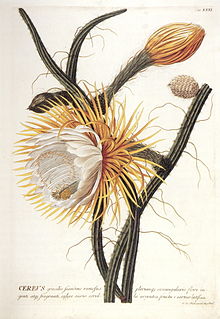Selenicereus grandiflorus
| Queen of the night | |
|---|---|
 |
|
| Scientific classification | |
| Kingdom: | Plantae |
| (unranked): | Angiosperms |
| (unranked): | Eudicots |
| (unranked): | Core eudicots |
| Order: | Caryophyllales |
| Family: | Cactaceae |
| Subfamily: | Cactoideae |
| Tribe: | Hylocereeae |
| Genus: | Selenicereus |
| Species: | S. grandiflorus |
| Binomial name | |
|
Selenicereus grandiflorus (L.) Britton & Rose, (1909) Contr. US Nat. Herb. 2:430 |
|
| Synonyms | |
|
Cactus grandiflorus L. (1753) Sp. Pl. 467 |
|
Cactus grandiflorus L. (1753) Sp. Pl. 467
Cereus donkelaarii Salm-Dyck Allg. Gartenz. xiii.
Cereus grandiflorus (L.) Mill. (1768) Gard. Dict. ed. 8, no 11
Cereus grandiflorus affinis Salm-Dyck (1850) Cact. Hort. Dyck. 1849:51, 216
Cereus grandiflorus var. spectabilis Karwinsky in Förster (1846) Handb.Cact. 415
Cereus scandens minor Boerhaave in Arendt (1891) Monatsschr. Kakteenk. 1:82
Cereus schmidtii (1894) Monatsschr. Kakteenk. 4:189
Cereus grandiflorus var. minor Salm-Dyck
Cereus tellii hort. in Hildmann (1895) Monatsschr. Kakt. 5:43
Cereus grandiflorus var. haitiensis (1903) Monatsschr. Kakteenk. 13:183
Cereus hondurensis K. Schumann in Weingart (1904) Monatsschr. Kakteenk. 14:147
Cereus grandiflorus uranos Riccobono (1909) Boo. R. Ort. Bot. Palermo 8:249
Selenicereus donkelaarii (Salm-Dyck) Britton & Rose (1917) Standard Cycl. Hortic. 3141
Selenicereus grandiflorus var. affinis (Salm-Dyck) Borg (1951) Cacti 206
Selenicereus grandiflorus var. tellii (hort. ex Riccobono) Borg (1951) Cacti 206
Selenicereus grandiflorus var. uranos (Riccobono) Borg (1951) 206
Cereus uranos hort.
Selenicereus hondurensis (K. Schumann) Britton & Rose (1909) Contr. US. Nat Herb. 12:430
Selenicereus grandiflorus is a cactus species originating from the Antilles, Mexico and Central America. The species is commonly referred to as ,night-blooming cereus (though these two terms are also used for other species), large-flowered cactus, sweet-scented cactus or vanilla cactus. The true species is extremely rare in cultivation. Most of the plants under this name belong to other species or hybrids. It is often confused with the species of Epiphyllum.
Grandiflorus (Lat.) = large flowered. When Carl von Linné descripted this cacti in 1753 it was the largest flowered species of cacti known. Paradoxically, are moderate in size compared with several other Selenicereus species.
The first species to be brought into cultivation. Linné (Linnaeus) descripted it in 1753, but it was known long before. Records from Hortus Kewensis gives that the species was grown at Royal Gardens at Hampton Court before 1700. There has been doubt about which plant was available to Linné when he drew up his description, but this is solved and both the plates on this side show the authentic species.
...
Wikipedia
